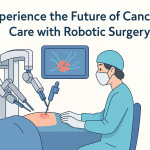
Experience the Future of Cancer Care with Robotic Surgery
I am Dr. Pradeep, Surgical Oncologist and Robotic Cancer Surgeon, and I’d like to share how robotic surgery is transforming the way we care for patients with cancer.
What Is Robotic Cancer Surgery?
Robotic surgery is a minimally invasive surgical technique where the surgeon operates through a specialized robotic system. The robot acts as an extension of the surgeon’s hands, providing unmatched steadiness, precision, and flexibility.

⚠️ Important: The robot does not work on its own — the surgeon is always in full control

Through a digital console, the surgeon sees a high-definition 3D view of the surgical area and uses robotic instruments to perform delicate procedures through tiny incisions.
Why Robotic Surgery in Cancer Treatment?
Cancer surgery once meant large incisions, more pain, and longer hospital stays. Laparoscopy improved this by introducing keyhole techniques, but robotic platforms take it even further.
- 3D visualization improves accuracy in delicate areas.
- Greater dexterity allows precise movements even in narrow spaces.
- Enhanced control makes complex cancer surgeries safer and more effective.
In the era of Precision Oncology and Artificial Intelligence, robotic surgery represents the future of surgical cancer care.
Benefits and Advantages of Robotic Surgery
Patients undergoing robotic surgery experience multiple benefits:
- ✅ Smaller, cosmetic incisions
- ✅ Minimal blood loss
- ✅ Less pain and fewer complications
- ✅ Shorter hospital stays
- ✅ Faster return to daily life and work
- ✅ Better outcomes in technically challenging cancer surgeries
What Types of Surgeries Can Be Done with Robotics?
Robotic surgery is versatile and can be applied to many specialties, especially cancer care:
- Cancer Surgeries: Uterine, cervical, stomach, colon, rectum, thyroid, parotid, lung, and oesophageal cancers.
- General Surgeries: Gallbladder removal, hernia repair.
- Gynaecology: Hysterectomy, myomectomy.
- Urology: Prostatectomy, nephrectomy, ureteric and bladder surgeries.
- Orthopaedics: Precision robotic knee replacement.
Post-Operative Benefits to Patients
Compared to open or even laparoscopic surgery, robotic surgery provides:
- Reduced need for ICU stay.
- Faster recovery and discharge.
- Less dependence on painkillers.
- Quick return to normal diet and mobility.
- Early resumption of work and daily activities.
This translates into not just a medical advantage, but also a significant emotional and financial benefit for patients and families.
Frequently Asked Questions (FAQs)
1. Is robotic cancer surgery safe?
Yes. Robotic systems are time-tested and surgeon-controlled. They have multiple safety protocols and backup systems to ensure patient safety at all times.
2. Does robotic surgery cost more?
While robotic systems involve advanced equipment, the overall cost is comparable to traditional surgery when you consider shorter hospital stays, reduced ICU use, and faster recovery.
3. Is robotic surgery better than laparoscopy?
Yes. Robotic surgery offers 3D vision, better dexterity, and precision, especially in complex cancer surgeries, where laparoscopy has limitations.
4. How long is recovery after robotic cancer surgery?
Most patients recover faster, with shorter hospital stays and a quicker return to normal life compared to open or laparoscopic procedures.
5. Can all cancer patients undergo robotic surgery?
Not all cases are suitable. The decision depends on the type, stage, and location of cancer. Your surgeon will guide you on whether robotic surgery is the best option.
A Strong Message to Remember
Robotic surgery is safe, smart, and precise — combining the expertise of the surgeon with cutting-edge technology to deliver the best outcomes.
For cancer patients, it means less pain, faster recovery, and more time with loved ones.
If you or your family member is considering cancer surgery, speak to your doctor about the role of robotic surgery. This may be the step that brings you not just healing, but also comfort, confidence, and hope for the future.
Experience the future of surgery — today.






